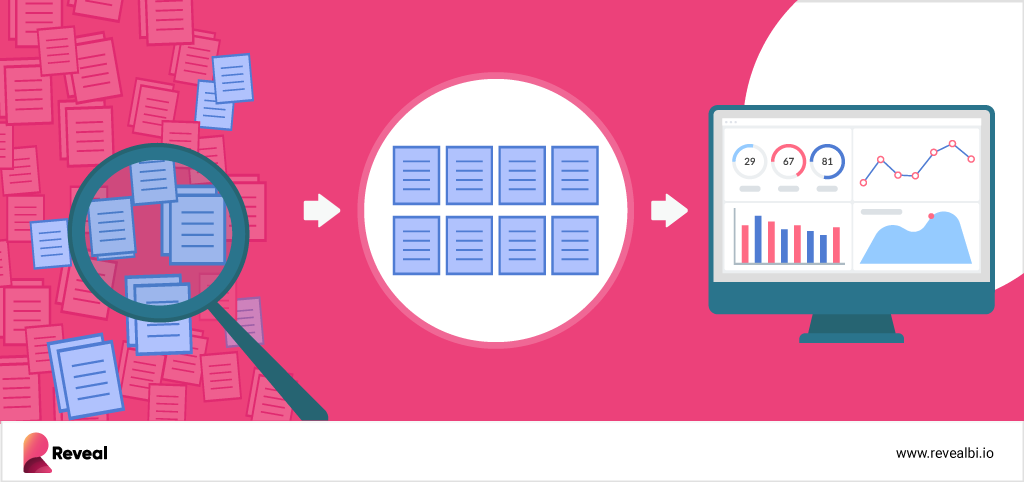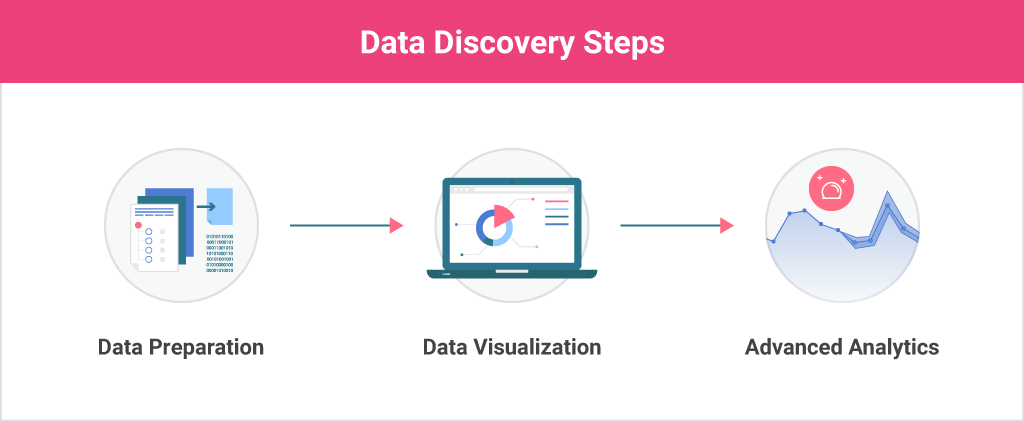
Data Discovery
What Is Data Discovery?
Today, all businesses collect huge amounts of data about their customers, suppliers, markets, and more. The data flows from everywhere, and as a result, the decision-makers are drowning in it. They need to uncover the insights hidden in their data.
Data discovery is a term related to business intelligence technology. It is a user-oriented process that involves collecting and evaluating data from various sources for detecting patterns and outliers by visually navigating data or applying guided advanced analytics.
Data discovery aims to reveal relevant data insights and communicate these insights to business users in an easy-to-understand way, and ultimately improve all business processes. For example, BI enables you to explore data in many different ways; region, product type, etc. By doing so, you get access to actionable insights in a matter of seconds. Visual data discovery tools make the process intuitive and easy even for non-technical users, which helps everyone make rapid, data-driven decisions in response to these discoveries.

Why Data Discovery Is Important?
Data discovery provides businesses with the tools, knowledge, and ability to analyze their data and uncover hidden insights that otherwise might have been lost. But its importance is wider. The benefits of data discovery for businesses include:
- Enhanced process of understanding the data the business owns, where it is stored, who can access it and where, and how it will be transmitted
- Continuous and comprehensive monitoring of data access and activity
- Risk management and regulatory compliance
- 100% data visibility
- Data classification based on context
- Identification, classification, and tracking of sensitive data
- Clean and reuse data
- Scale data across teams
Data Discovery Catagories
The three main data discovery categories are:
Data preparation – the data preparation category uses statistical techniques to merge unstructured, raw data from disparate sources, then clean, transform, and eliminate noise from the data so that quality is consistent and formatting is useable.
Data visualization – data visualization is the process of turning raw data into visual representations. Typically, those visualizations are in the form of charts and graphs. Data visualization aims to make data easier and faster to understand, even by people who are not trained in analytics or typically good with numbers. It is a critical process for analyzing big data and for displaying the results of machine learning and predictive analytics.
Advanced analytics – this data discovery category combines descriptive statistics and visuals to paint a complete picture of a business’s data. Descriptive statistics organize, summarize, and break down data into a simple, intelligible report that is easy to understand and helps businesses make smarter, fact-based decisions.

What Is Governed Data Discovery?
Data governance and data discovery go together hand-in-glove. Governed data discovery (GDD) is information/data that is centralized, secured, deployed, and managed by a governing department (usually IT) to ensure data integrity and security before other users can access it. It delivers enterprise features necessary for easy data delivery for business users while at the same time satisfying IT-driven requirements for managing and securing the data.
What Problems Can Data Discovery Solve?
Elevate Patient Care in the Healthcare Industry
The healthcare industry is taking full advantage of BI trends such as data discovery. Healthcare analytics is useful and valuable in everyday situations; it can, for example, monitor the quality of medical and healthcare institutions as well as provide better treatment methods. With predictive analytics in healthcare even greater things could be achieved – new treatments can be researched and discovered, the overall healthcare costs can be decreased, human errors are shed to a minimum, personalized treatments can be prescribed, and so much more.
Forecasts Sales & Maximizes Profits in the Retail Industry
Bringing the value of analytics and data discovery to your retail business opens the door for plenty of opportunities. By being able to utilize such tools to forecast trends and sales, you can set your pricing and marketing strategies in any direction that would best fit your interests. Retail analytics allows you to track your competitors’ prices, your audience behavior, and more, so you find out when and how much you can increase or decrease your prices in order to maximize your profits and sell more.
Improve Customer Retention & Customer Value in the Finance Industry
Analytics and data discovery tools offer financial services providers myriad opportunities to learn more about their customers and act on these insights. For example, data discovery tools can help them determine which products and services a particular customer is using and then, based on these insights, determine the customer’s lifecycle status and other factors, such as whether is he/she a good candidate for a cross-sell or upsell offerings. Finance analytics generate data-driven insights and help businesses make smarter and more informed decisions.
What Should You Look for in Data Discovery Tools?
There are data discovery tools that currently exist as standalone applications or as embedded analytics solutions. Both types of data discovery tools have been built to improve traditional BI tools and capabilities. However, they all range in functionalities.
As previously mentioned, there are three main data discovery steps: data preparation, data visualization, and advanced analytics. The tool you decide to partner with should provide the foundation for these three crucial stages, and that is the least you should look for in a data discovery tool. Here’s what else you need to seek:
Modern, intuitive, and quick solution – easy to use and understand analytics- is crucial to every modern SaaS application. You don’t want to invest in a solution that is already outdated, and that would make your users’ workflow more complex. Modern analytics applications like embedded analytics enable non-technical users to manage and work with data themselves by providing self-service and modern architecture capabilities. These kinds of solutions deliver robust features and advanced analytics capabilities so that your users can reveal valuable insights in the context of their workflow and act at the moment of impact.
Rich library of data visualization options – a spreadsheet with hundreds of rows of numbers can seem terrifying to someone not trained in data analytics. But if that person takes a look at a graph, chart, or another visual data representation, they can easily understand what the data is trying to tell them and extract important insights from it. A good analytics vendor will offer a library of rich charts such as column, line, or combo to more advanced ones such as treemap or geospatial mapping. Having the option to choose from many different visualizations will help you better present and understand your data, as not every chart type is suitable for every occasion.
Augmented analytics – powered by two of the greatest analytics technologies, machine learning and AI, augmented analytics makes it possible for users to ask questions and automatically generate insights by exploring their data using conversational language. One of its best advantages is augmented data preparation. By using AI/ML automation to bring data together from multiple data sources faster, algorithms replace manual processes and automate the data preparation process in a fraction of the time. That saves data scientists 45% of their time and energy, all while enhancing productivity and efficiency.
Be mobile-friendly – having important company insights at your fingertips is the most valuable advantage of mobile BI. When decisions must be made or when actions must be taken, mobile BI allows you to access and act on data from your mobile phone at any time and from any location by providing users with the most up-to-date insights.
Data catalog – data catalog uses metadata combined with data management and search tools to help businesses manage their data and discover, understand, and trust their data for governance or business purposes. Thanks to the available metadata, data catalogs can help users accelerate the data discovery process up to 5 times. Moreover, data catalogs have the ability to discover sensitive data about your customers that you might not even know you were storing. This is very useful for GDPR and other data protection regulations.
Embedding data discovery into your existing software will change how your business works and utilizes data forever. Today, many businesses across different industries have already made the step towards better, faster, and smarter data preparation. Start today if you haven’t already, and allow your business to make real-time, data-driven decisions across teams and departments, gain a competitive advantage, and ultimately grow your profits.


